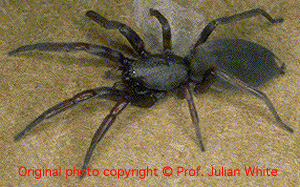 The white tailed spider, Lampona cylindrata This common
hunting spider, found in houses, has been linked with necrotic arachnidism,
often tenuously. Experience with definite bites by this spider has generally
been that both pain and local reactions were mild to moderate, with very
few cases where ulceration developed. Venom research has failed to confirm
that this spider damages skin. While the white-tailed spider cannot yet
be excluded as a cause of necrotic arachnidism, there is no evidence to
suggest that it is the major cause. Bites by organisms unknown, causing
ulceration, should NOT be labelled as "white-tailed" spider
bites.
The white tailed spider, Lampona cylindrata This common
hunting spider, found in houses, has been linked with necrotic arachnidism,
often tenuously. Experience with definite bites by this spider has generally
been that both pain and local reactions were mild to moderate, with very
few cases where ulceration developed. Venom research has failed to confirm
that this spider damages skin. While the white-tailed spider cannot yet
be excluded as a cause of necrotic arachnidism, there is no evidence to
suggest that it is the major cause. Bites by organisms unknown, causing
ulceration, should NOT be labelled as "white-tailed" spider
bites.
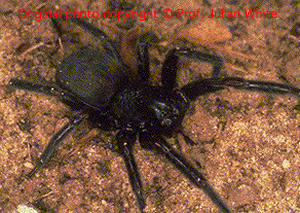 A robust black spider found in untidy webs with a tube retreat.
Common in urban habitats. Its bite can cause moderate local pain, with
erythema and swelling, and occasionally mild systemic symptoms. The black
house spider ia a likely candidate for causing some cases of necrotic
arachnidism.
A robust black spider found in untidy webs with a tube retreat.
Common in urban habitats. Its bite can cause moderate local pain, with
erythema and swelling, and occasionally mild systemic symptoms. The black
house spider ia a likely candidate for causing some cases of necrotic
arachnidism.
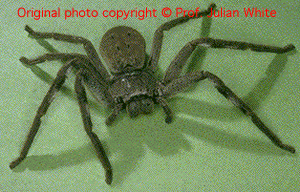 There are many species, common inside houses, but bites are
generally very mild, with short lived pain. A few species can occasionally
also cause mild systemic symptoms, notably headache and nausea.
There are many species, common inside houses, but bites are
generally very mild, with short lived pain. A few species can occasionally
also cause mild systemic symptoms, notably headache and nausea.
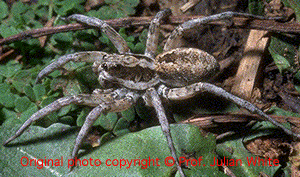 Many species of these ground hunting spiders are common in
gardens, sometimes entering houses. Few bites are recorded and on this
limited evidence, it appears bites are minor.
Many species of these ground hunting spiders are common in
gardens, sometimes entering houses. Few bites are recorded and on this
limited evidence, it appears bites are minor.
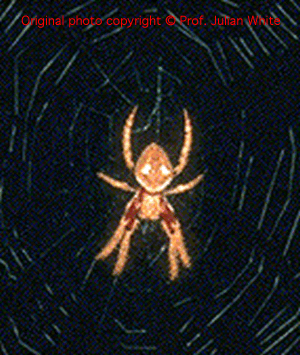 These common spiders, with many species, build "typical" spider
webs in the garden at night. People walking into the web and crushing
the spider against their body may be bitten, resulting in mild local pain
and a small red lump, lasting about 24 hours. These spiders may also hide
in clothing left outside overnight, on washing lines. The next person
to put the clothing on may be bitten!
These common spiders, with many species, build "typical" spider
webs in the garden at night. People walking into the web and crushing
the spider against their body may be bitten, resulting in mild local pain
and a small red lump, lasting about 24 hours. These spiders may also hide
in clothing left outside overnight, on washing lines. The next person
to put the clothing on may be bitten!
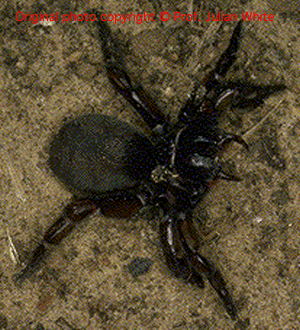 Again, a number of species of robust, ground dwelling, burrowing
spiders, with very large fangs. They are often dug up in gardens. Bites
appear to cause surprisingly mild pain, given the spider's size, and no
systemic problems.
Again, a number of species of robust, ground dwelling, burrowing
spiders, with very large fangs. They are often dug up in gardens. Bites
appear to cause surprisingly mild pain, given the spider's size, and no
systemic problems.
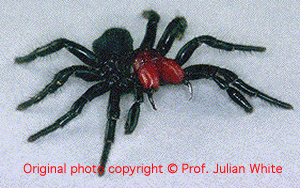 Ground dwelling spiders with large fangs, and venom which
is reported to be more toxic than that of the funnel web spider (in tests
involving mice). Apart from a single case from Queensland, all reported
bites by these spiders have been minor. The Queensland case had some similarity
to envenoming by a funnel web spider. There is a growing body of research
suggesting that this spider could cause major envenoming, similar to that
of the funnel-web spider, and is likely to be responsive to CSL Funnel
Web Spider Antivenom, although this is not yet an approved indication.
Ground dwelling spiders with large fangs, and venom which
is reported to be more toxic than that of the funnel web spider (in tests
involving mice). Apart from a single case from Queensland, all reported
bites by these spiders have been minor. The Queensland case had some similarity
to envenoming by a funnel web spider. There is a growing body of research
suggesting that this spider could cause major envenoming, similar to that
of the funnel-web spider, and is likely to be responsive to CSL Funnel
Web Spider Antivenom, although this is not yet an approved indication.
These have fangs and venom glands at the head end and bites may cause severe local pain. Infection sometimes occurs, which is occasionaly severe.
None of the many species of Australian scorpions is dangerous to humans but most cause intense local pain when they sting. This usually lasts only a short while, and systemic symptoms rarely occur and are never severe.
The most important ticks are those which cause paralysis, discussed under the section on tick antivenom. Many other ticks may bite humans causing a variety of local reactions, usually local irritation or pruritis. A few may sometimes cause a mild systemic illness, including malaise, nausea or headaches.
It should be noted that ticks do transmit a variety of diseases, both in Australia and overseas. A discussion of this problem is beyond the scope of this publication, but some of these tick borne diseases can be severe.